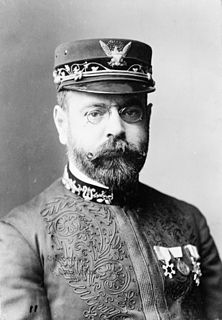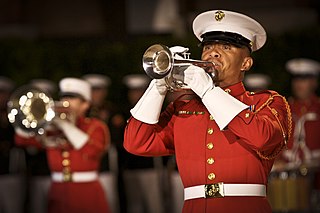History
There does not exist an original general order documenting the proclamation of Semper Fidelis as the official march of the Marines. According to accounts summarized in the CD liner notes, [1] Sousa is regarded by historians as honest and on many occasions noted that the march was named the official march of the Marine Corps. However, a flood destroyed many Marine Corps records, even those documenting Sousa's rank as leader of the United States Marine Corps Band; an order designating it as an official march could have been lost. [1] The United States Marine Corps website refers to the song as "the Official March of the Marine Corps". [2]
Sousa began as the musical conductor of the United States Marine Corps Band, known as "The President's Own", in 1880 and led the Band for five presidential administrations. [2] President Arthur felt that Hail to the Chief was undignified and requested a new presidential composition. Sousa began performing Presidential Polonaise (1886) and later Semper Fidelis, although Arthur predeceased the latter. Neither displaced Hail to the Chief as the song most closely associated with the United States President. [3] [4]
In an October 1927 interview published in the Independent (Nebraska), Sousa claimed "I wrote Semper Fidelis one night while in tears after my comrades of the Marine Corps had sung their famous Hymn at Quantico (which is now home to Marine Corps Base Quantico)." However, no Marines were stationed at Quantico until May 14, 1917 and he wrote the song in 1888. This could be explained by a misquote or by Marine maneuvers or exercises at Quantico. [1]

John Philip Sousa was an American composer and conductor of the late Romantic era known primarily for American military marches. He is known as "The March King" or the "American March King", to distinguish him from his British counterpart Kenneth J. Alford. Among his best-known marches are "The Stars and Stripes Forever", "Semper Fidelis", "The Liberty Bell", "The Thunderer", and "The Washington Post".

American march music is march music written and/or performed in the United States. Its origins are those of European composers borrowing from the military music of the Ottoman Empire in place there from the 16th century. The American genre developed after the British model during the colonial and Revolutionary periods, then later as military ceremonials and for civilian entertainment events.
"The Liberty Bell" (1893) is an American military march composed by John Philip Sousa.
Semper fidelis is a Latin phrase that means "always faithful" or "always loyal". It is the motto of the United States Marine Corps, usually shortened to Semper Fi. It is also in use as a motto for towns, families, schools, and other military units.
"Hail to the Chief" is the personal anthem of the President of the United States, adapted by James Sanderson from an original Scottish Gaelic melody.

The United States Marine Band is the premier band of the United States Marine Corps. Established by act of Congress on July 11, 1798, it is the oldest of the United States military bands and the oldest professional musical organization in the United States. Today, the Marine Band also includes the Marine Chamber Orchestra and Marine Chamber Ensembles.

The United States Marine Drum & Bugle Corps is the drum and bugle corps of the United States Marine Corps. The D&B is now the only full-time active duty drum corps in the United States Armed Forces. As one of many United States military bands, the United States Marine Drum & Bugle Corps consists of 80 active-duty Marines dressed in ceremonial red and white uniforms. The D&B performs martial and popular music.

Richard "Rick" Treat Spooner is a former officer in the United States Marine Corps and the proprietor of The Globe and Laurel Restaurant in Stafford, Virginia, just a few miles south of the main gate of Marine Corps Base Quantico. He served in the Marine Corps for over 29 years.

"National Emblem", also known as the National Emblem March, is a U.S. march composed in 1902 and published in 1906 by Edwin Eugene Bagley. It is a standard of the U.S. march repertoire, appearing in eleven published editions. The U.S. military uses the trio section as ceremonial music for the entry of the ceremony's official party.

The National Museum of the Marine Corps is the historical museum of the United States Marine Corps. Located in Triangle, Virginia near MCB Quantico, the museum opened on November 10, 2006, and is now one of the top tourist attractions in the state, drawing over 500,000 people annually.
"The Gladiator" is a march by John Philip Sousa, written in 1886 while Sousa was leader of the US Marine Band.

Stars and Stripes Forever is a 1952 American Technicolor film biography of the late-19th-/early-20th-century composer and band leader John Philip Sousa. This 20th Century Fox feature was produced by Lamar Trotti, directed by Henry Koster, and stars Clifton Webb, Debra Paget, Robert Wagner, and Ruth Hussey. The film's title is taken from Sousa's "The Stars and Stripes Forever", which has become the best known of his military marches. The film was released twenty years after Sousa's death.
The culture of the United States Marine Corps is widely varied but unique amongst the branches of the United States Armed Forces. Because members of the United States Marine Corps are drawn from across the United States, it is as varied as each individual Marine but tied together with core values and traditions passed from generation to generation of Marines. As in any military organization, the official and unofficial traditions of the Marine Corps serve to reinforce camaraderie and set the service apart from others. The Corps' embracement of its rich culture and history is cited as a reason for its high esprit de corps.

The United States Marine Corps History Division is a branch of Headquarters Marine Corps tasked with researching, writing, and maintaining the History of the United States Marine Corps. It also provides reference and research assistance; preserves personal experiences and observations through oral history interviews; and deploys field historians to record history in the making. It is headquartered at Marine Corps Base Quantico in Virginia.
Semper fidelis is a Latin phrase that means "always faithful" – it serves globally as a common motto for several military units.
"The Royal Welch Fusiliers" is a march composed by John Philip Sousa in 1929, and then rewritten in 1930. It is the only march written by Sousa for a British Army regiment.

The John Philip Sousa Baton is a conducting baton originally presented to John Philip Sousa upon his resignation as the director of the United States Marine Band. After his death, it was donated to the Marine Band, and since it has been traditionally passed to the new director from the outgoing director of the band during the change of command ceremonies.

"Anchor & Star" is an American military march composed by John Philip Sousa in 1918, while he served as leader of the U.S. Navy Battalion Band at the Great Lakes Naval Training Center during the First World War.

Boy Scouts of America is a march composed by John Philip Sousa in 1916 upon the request of Charles D. Hart. Sousa dedicated it to the Boy Scouts of America. It was premiered in October 1916 at the Metropolitan Opera House. The cover sheet features a photograph of a statuette R. Tait McKenzie's The Ideal Scout. It is considered one of the best marches Sousa ever composed, with The Reading Times writing that the march proved that the "noted composer still retains the name of 'March King'".













